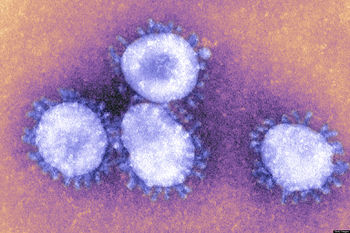Middle East respiratory syndrome coronavirus: Difference between revisions
Hae.Y.Cha-1 (talk | contribs) |
Hae.Y.Cha-1 (talk | contribs) No edit summary |
||
| Line 2: | Line 2: | ||
[[Category:Pages edited by students of Tyrrell Conway at the University of Oklahoma]][[Image:OULOGOBIANCO.JPEG|thumb|230px|left|University of Oklahoma Study Abroad Microbiology in Arezzo, Italy[http://cas.ou.edu/study-abroad/]]] | [[Category:Pages edited by students of Tyrrell Conway at the University of Oklahoma]][[Image:OULOGOBIANCO.JPEG|thumb|230px|left|University of Oklahoma Study Abroad Microbiology in Arezzo, Italy[http://cas.ou.edu/study-abroad/]]] | ||
[[Image:MERS_virus.jpeg|thumb|350px|right|''MERS-CoV. From dohanews: [http://dohanews.co/health-council-reports-new-mers-case-qatar/]]] | |||
==Etiology/Bacteriology== | ==Etiology/Bacteriology== | ||
Revision as of 08:59, 25 July 2015


Etiology/Bacteriology
Taxonomy
Viruses; ssRNA viruses; ssRNA positive-strand viruses, no DNA stage; Nidovirales; Coronaviridae; Coronavirinae; Betacoronavirus; unclassified Betacoronavirus
Description
Middle East respiratory syndrome coronavirus (MERS-CoV) infects the respiratory system, causing the severe acute illness Middle East respiratory syndrome also known as MERS. It was first identified in Jiddah, Saudi Arabia in 2012 and soon afterward seen in other Middle Eastern countries including Jordan, Qatar, and the United Arab Emirates. In other cases, it has been observed in countries including France, Germany, Italy, the United Arab Emirates, China, Malaysia, South Korea, and the United States. All confirmed cases are linked to the Arabian Peninsula. Coronaviruses are characterized by their crown-like, coronal glycoprotein spikes on their surface. They have enveloped virions that measure approximately 120nm in diameter with a nucleocapsid made up of viral nucleic acids and are helical in shape. The genome consists of a single strand of RNA. [1]
Pathogenesis
Transmission
Infectious Dose, Incubation, Colonization
Epidemiology
Virulence Factors
Clinical features
Symptoms
Morbidity and Mortality
Diagnosis
Prevention and Treatment
Currently, there are no vaccines for prevention or specific antiviral treatments for cures. However, individuals with MERS-CoV infection can seek medical attention to relieve symptoms and receive support for boosted organ functions. The CDC recommends avoiding personal contact and frequent hand washing in order to prevent respiratory illnesses.[2]
Host Immune Response
References
1 "MERS." Encyclopaedia Britannica. Britannica Academic. Encyclopædia Britannica Inc., 2015. Web. 22 Jul. 2015. <http://academic.eb.com/EBchecked/topic/1949834/MERS>
2 Centers for Disease Control and Prevention, Middle East Respiratory Syndrome (MERS) <http://www.cdc.gov/coronavirus/mers/index.html>
Created by Hae Cha, students of Tyrrell Conway at the University of Oklahoma.
